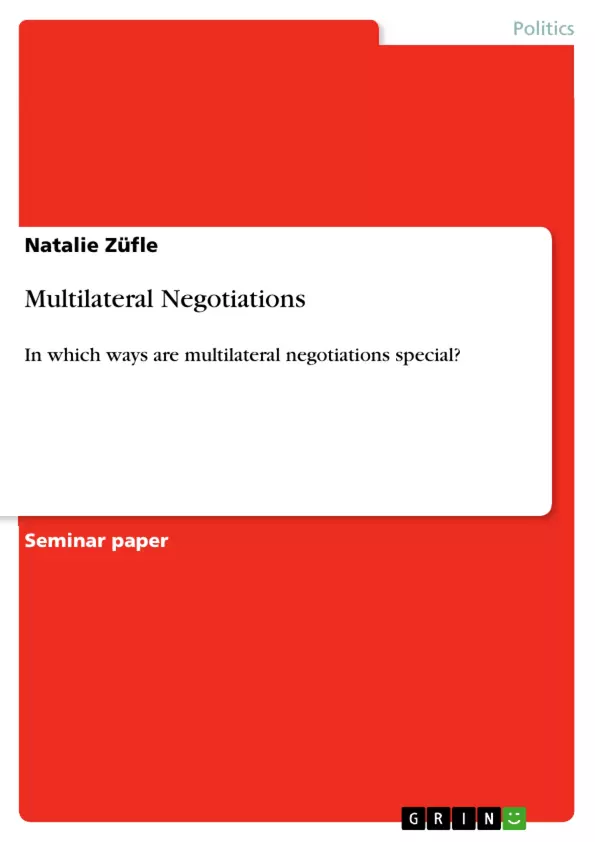The four illustrated aspects, i.e. number of actors and issues, communication process as well as the building of coalitions exemplary show that certain specifics are only inherent in multilateral negotiations, making them much more complex and with it, last but not least, fundamentally different from bilateral bargaining.
Inhaltsverzeichnis (Table of Contents)
- Actors
- Issues
- Communication
- Coalitions
Zielsetzung und Themenschwerpunkte (Objectives and Key Themes)
This essay aims to analyze the unique characteristics of multilateral negotiations compared to bilateral bargaining. Drawing on scholarly literature, it explores the distinct features of multilateral negotiations, highlighting how they differ from their bilateral counterparts.
- The increased complexity of multilateral negotiations due to a greater number of actors and issues
- The role of communication challenges in multilateral negotiations, particularly regarding information processing and the potential for misunderstandings
- The formation of coalitions in multilateral negotiations as a means of reducing complexity and facilitating consensus
- The impact of diverse interests and belief systems on multilateral negotiations
- The growing importance of non-state actors in multilateral negotiations
Zusammenfassung der Kapitel (Chapter Summaries)
The essay begins by acknowledging the significant increase in multilateral negotiations since World War II, driven by globalization and interdependence. It then discusses the complexities inherent in multilateral negotiations, contrasting them with the relative simplicity of bilateral bargaining.
The essay explores the key distinctions between multilateral and bilateral negotiations, focusing on four key aspects:
Actors: The essay highlights the greater number of actors involved in multilateral negotiations, including both state and non-state actors. It acknowledges the growing influence of non-state actors such as transnational corporations (TNCs), international organizations (IOs), and non-governmental organizations (NGOs).
Issues: The essay examines the expansion of the negotiation agenda, driven by the emergence of new global issues such as environmental concerns, economic affairs, and security threats like international terrorism and the proliferation of weapons of mass destruction.
Communication: The essay emphasizes the increased communication challenges in multilateral negotiations, resulting from a greater number of participants, issues, and information flow. It explores the potential for misunderstandings, conflicting messages, and the difficulties in reaching consensus.
Coalitions: The essay explores the crucial role of coalition-building in multilateral negotiations. It highlights how coalitions can simplify information processing and reduce complexity, facilitating communication and agreement-making.
Schlüsselwörter (Keywords)
Multilateral Negotiations, Bilateral Negotiations, International Negotiations, Interdependence, Globalization, Actors, Issues, Communication, Coalitions, Complexity, Consensus, Non-State Actors, Transnational Corporations (TNCs), International Organizations (IOs), Non-Governmental Organizations (NGOs), Epistemic Communities, Diversity of Interests, Belief Systems, Ideology.
- Arbeit zitieren
- Natalie Züfle (Autor:in), 2009, Multilateral Negotiations , München, GRIN Verlag, https://www.grin.com/document/180075



